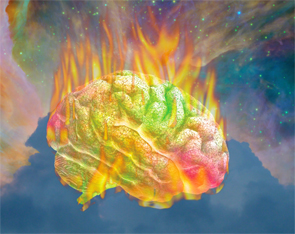
Rheumatologists routinely deal with mood issues that may shroud the benefits of the drugs we prescribe.
Image Credit: Bruce Rolff/shutterstock.com
The Friday night press release: When a politician or any public figure needs to disclose unfavorable news, chances are they will release it sometime on a late Friday afternoon or evening, hoping that nobody is paying attention. In fact, this behavior was coined “the take out the trash day” on the television political drama, The West Wing. The likelihood of a press release fading into oblivion gets even better whenever it is disclosed on the Friday before a long weekend break. Guaranteed to achieve complete obscurity, or so claim the consultants who specialize in these sorts of things.
The press release dated Friday, May 22, 2015, at the start of the Memorial Day long weekend was decidedly low key.1 Most of its 1,200-plus words consisted of boilerplate jargon, but the first sentence said it all: “Amgen today announced (it) has commenced termination of its participation in the co-development and commercialization of brodalumab with AstraZeneca. Brodalumab, an investigational IL-17 inhibitor, is in development for patients with moderate-to-severe plaque psoriasis, psoriatic arthritis and axial spondyloarthritis. The decision was based on events of suicidal ideation and behavior in the brodalumab program, which Amgen believes likely would necessitate restrictive labeling.”
Have I read this correctly? Do we have our drug classes confused? As rheumatologists, we are accustomed to dealing with mood issues that may shroud the benefits of some of the drugs that we prescribe: Pain-modifying medicines, such as pregabalin and tramadol, are frequent offenders, and rarely, antimalarial agents, such as hydroxychloroquine, precipitate nightmares. Of course, corticosteroids are the greatest mood-offending drugs we prescribe. How often have we witnessed a troubling steroid-induced mood swing or, even worse, the unmasking of an underlying psychosis? Even lower doses of steroids are not immune, because they too can create feelings of anxiety or depression in some individuals.
In contrast, scant evidence implicates biological therapies as drivers of mood disorders. One exception may be belimumab. The data submitted to the Food and Drug Administration (FDA) by its manufacturer included information on a total of seven suicide attempts that were recorded in the various study protocols of this anti-B cell therapy.2 To use drug-study parlance, three were completed suicides. In contrast, data derived from the FDA’s spontaneous report system concluded that the rate of suicide and depression among users of TNF-inhibiting drugs was not disproportionate to the frequency of their use.3 This latter observation is in keeping with what we see in clinical practice. If anything, because biological therapies frequently enhance the quality our patients’ lives, they may indirectly improve their mood.
Yet, in some ways, this apparent lack of interaction between drugs that target some of the key effector molecules in the immune system and the various mood disorders is somewhat surprising. Burgeoning neurobiology literature implicates a critical role for the immune system in the pathogenesis of various mood disorders, autism, depression and suicide. Thus, one might have expected our experience with biologics to mimic the occasionally messy circumstances that confound corticosteroid use: The patient’s condition improves, but their ensuing personality change becomes intolerable. They become moody, agitated, anxious and difficult to live with. Or, as I once bore witness to, they plunge into the darkest depths of despair and take their own life. Completed suicide.
Our Immune Systems & Our Psyche
The relationship between mental health and inflammation was first noted in 1887 by Julius Wagner-Jauregg, MD, of the University of Vienna, Austria, who won the Nobel Prize in Medicine in 1927, making him the only psychiatrist to ever win this award. Over the ensuing decades, the elegant elucidation of the maze of neuroendocrine pathways coursing through our bodies and our brains has highlighted the intricate role that glucocorticoids play in maintaining both physiologic and psychological homeostasis during periods of serenity and stress, in serving as a bulwark against the evil forces of autoimmunity and, not surprisingly, in modulating fear, anxiety and trepidation. Glucocorticoid receptors (GRs) have been identified in the hypothalamus and hippocampus, and more recently, they have been detected in the amygdala, the almond-shaped structure buried deep inside our brains that encodes both fear and anxiety. A recent study of post-mortem brain tissue found that GR protein levels, as well as the percentage of GR-containing astrocytes, were significantly higher in the amygdala of patients who suffered from major depression than in control subjects or those with less severe forms of bipolar depression.4
GRs are far from being the only molecular link between mood and immunity. Animal models suggest that systemic inflammatory cytokines, such as interleukin 6 (IL-6), can influence mood. Injection of IL-6 in healthy human volunteers induces low mood, anxiety and reduced cognitive performance. Given its significant role in mediating systemic inflammation, this behavioral link makes perfect sense from an evolutionary viewpoint.
The mood–immune link might be best summarized by the theory of sickness behavior, which consists of a set of behavioral changes, including lethargy, social withdrawal, loss of appetite and anhedonia, that overlap with depression.5 They are thought to provide evolutionary advantages that ensure an organism’s survival during periods of illness. Under normal circumstances, the immune system clears the source of inflammation and sickness behavior resolves because this adaptive behavioral response is no longer advantageous. However, when it lingers, it transforms to a maladaptive sickness—depression.
It has been proposed that an increase in circulating levels of IL-6 may decrease the availability of serotonin and other neurotransmitters, and simultaneously activate the hypothalamic-pituitary-adrenal axis, resulting in increased oxidative stress in the brain. Is this merely a short-term stress-related effect, a cerebral version of Walter Cannon’s fight or flight hypothesis, or can the effects last longer? A longitudinal study of a cohort of 4,500 British adolescents followed from birth observed that higher levels of circulating IL-6 in childhood were significantly associated with an increased risk of developing depression and psychosis in young adulthood.6
There may be a host of other links between pro-inflammatory cytokines and mood. Anecdotal evidence obtained from earlier immunotherapy trials in oncology and hepatology suggest that when used as therapeutic agents, cytokines, including IL-2 and gamma-interferon, are capable of inducing depression.7
Brain on Fire
Aside from activated pro-inflammatory cytokine pathways, other critical immune mechanisms can trigger aberrant behaviors and influence mood. An intriguing story concerns the induction of autoimmunity targeting the brain’s glutamine receptors and how this aberrant immune response may play a critical role in the pathogenesis of some of the neuropsychiatric features of lupus. The glutamate receptor, N-methyl-D-aspartate (NMDA), is a complex structure responsible for regulating glutamate, the main excitatory neurotransmitter in the brain. Activation of these receptors plays a key role in learning and memory formation and may help regulate synaptic strength and neural plasticity. These receptors may also help control mood and behavior. When consumed, psychotropic drugs, such as phencyclidine (better known by its street appellation, angel dust), inhibit the function of these receptors and, with prolonged use, may cause severely altered thought disturbances, depression and personality changes—just ask any medical resident who worked in an emergency department a few decades ago at the height of this drug’s popularity. Some researchers speculate that a similar biochemical situation may be occurring in the minds of schizophrenics.8 Others have carried this idea forward in an effort to solve the vexing issue of what causes lupus cerebritis.
Elegant work conducted by our colleague, Betty Diamond, MD, professor of molecular medicine at Hofstra North Shore Long Island Jewish Hospital in New York, has demonstrated that antibodies targeting the NMDA receptor are cross-reactive with double-stranded DNA and are present in a large percentage of patients with lupus.9 She and her colleagues have shown that when these antibodies are circulating in the serum of mice, there is no tissue damage in the brain because they lack access to brain tissue. Antibody-mediated neuronal damage can occur only following an insult that abrogates the blood–brain barrier (BBB), nature’s border-crossing mechanism that shields the brain from the rest of the body. However, when the BBB is breached, for example, in times of extreme stress following the release of epinephrine or with infection and the release of lipopolysaccharide, antibody-mediated neuronal death occurs in the hippocampus, resulting in impaired memory function. This appears to be the case in some murine models of lupus cerebritis. But what actually happens in humans? Are autoantibodies targeting the NMDA receptor relevant to human lupus cerebritis or other neuroinflammatory disorders?
The beauty of rheumatology may lie in the fact that our specialty lacks boundaries. Rhumatologues sans frontières! … Autoimmune illnesses can pop up anywhere.
Throughout history, the concept of demon possession has captivated the public’s attention. Many religious leaders considered some individuals to be infiltrated by devilish creatures. Clinical manifestations included explosive episodes of rage, extreme aggression toward others and oneself, speech deterioration, sudden “shouts in unknown tongue” and “bouts of contorted postures into seemingly impossible shapes,” propagating vibrations and even “movements to surrounding pieces of furniture.” These were some of the terms used to describe the case of a 14-year-old boy in St. Louis, Mo., whose story was popularized decades later in the blockbuster movie, The Exorcist. It is now believed that he suffered from a rare pediatric form of NMDA-receptor autoimmunity-inducing encephalitis.10
Although antibodies to NMDA receptor were not measured back then, a more recent case that gained widespread attention provided the clinical proof. Susannah Cahalan, a 24-year-old reporter for the New York Post, started to notice a change in her behavior. She first became anxious, then agitated and very paranoid. A seizure episode followed, then another, followed by worsening delusional and suicidal behavior and, finally, catatonia. A lumbar puncture identified a leukocytosis. Coupled with her other findings, an astute neurologist speculated that she was not schizophrenic but was suffering from an autoimmune illness, likely a cerebritis, that was being driven by the generation of autoantibodies targeting the NMDA receptor. He recalled a recent paper describing a similar syndrome affecting women with ovarian teratomas who were found to have very high circulating titers of these antibodies.11 In this case, the presence of these autoantibodies was confirmed, and Cahalan was treated and made a full recovery. She describes her ordeal in the book, Brain on Fire, which is soon to be released as a movie, too.12
Whether a similar form of this illness might be occurring in some of our lupus patients with cerebritis is not yet settled. Although these are rare conditions, gaining a better insight into the pathogenesis of these disorders will provide us with more than just a glimpse of how the mind works in health and in disease.
Tying It All Together
The beauty of rheumatology may lie in the fact that our specialty lacks boundaries. Rhumatologues sans frontières! We are not constrained by the physical location of our connective tissues nor limited by the reach of our immune system, which lacks an identifiable home. Autoimmune illnesses can pop up anywhere.
For years, it was believed that the BBB performed an effective job in keeping the brain isolated from the toxins, humors and microorganisms that occupy the rest of our body’s real estate. Two recent developments have shaken this dictum. First, was the discovery that the mammalian brain, long thought to lack a lymphatic system, actually contains canonical lymphatic vessels that bear the molecular markers of the structures that carry fluid and immune cells from the tissues to the lymph nodes elsewhere in the body.13 This observation raises the tantalizing possibility there is far more crosstalk between the brain, the body and the immune system than was previously imagined.
A second finding was recently described in a mouse model of an autism spectrum disorder. In this model, feeding rodents the human commensal Bacteroides fragilis corrected their underlying gut permeability, altered their microbial composition and, most strikingly, reversed the defects in their communicative, stereotypic and anxiety-like behaviors, suggesting that gut bacterial effects on the host metabolome can impact behavior.14 The brain and the mind, the bowel and the immune system are all linked together. To paraphrase Winston Churchill, although the mind remains a riddle wrapped in a mystery inside an enigma, perhaps the wrapping is not as impenetrable as once imagined.
 Simon M. Helfgott, MD, is associate professor of medicine in the Division of Rheumatology, Immunology and Allergy at Harvard Medical School in Boston.
Simon M. Helfgott, MD, is associate professor of medicine in the Division of Rheumatology, Immunology and Allergy at Harvard Medical School in Boston.
References
- Amgen to terminate participation in co-development and commercialization of brodalumab. Press release. 2015 May 22.
- Herper M. Suicide is surprise in FDA review of lupus. Forbes. 2010 Nov 12.
- Castilla-Puentes R. Exploring depression and suicide in patients receiving TNF alpha inhibitors using data mining techniques. World J Biol Psychiatry. 2014;S-096—Symposium, abstract.
- Wang Q, Verweij EWE, Krugers HJ, et al. Distribution of the glucocorticoid receptor in the human amygdala; changes in mood disorder patients. Brain Struct Funct. 2014 Sep;219(5):1615–1626.
- Haase J, Bonisch H. Integrating the monoamine, neurotrophin and cytokine hypothesis of depression—A central role for the serotonin transporter? Pharmacol Ther. 2015 Mar;147:1–11.
- Khandaker GM, Pearson RM, Zammit S, et al. Association of serum interleukin 6 and C-reactive protein in childhood with depression and psychosis in young adult life: A population-based longitudinal study. JAMA Psychiatry. 2014;71(10):1121–1128.
- Rosenblat JD, Cha DS, Mansur RB, et al. Inflamed moods: A review of the interactions between inflammation and mood disorders. Prog Neuropsychopharmacol Biol Psychiatry. 2014 Aug 4;53:23–34.
- Upthegrove R, Manzanares-Teson N, Barnes NM. Cytokine function in medication naive first episode psychosis. A systematic review and meta-analysis. Shizophr Res. 2014 May;155(1–3):101–108.
- Diamond B. Antibodies and the brain. Lessons from lupus. J Immunol. 2010 Sep 1;185(5):2637–2640.
- Sébire G. In search of lost time from ‘demonic possession’ to anti-N-methyl-daspartate receptor encephalitis. Ann Neurol. 2010 Jan;67(1):141–142.
- Dalmau J, Tuzun E, Wu HY, et al. Paraneoplastic anti-N-methyl-D-aspartate receptor encephalitis associated with ovarian teratoma. Ann Neurol. 2007 Jan;61(1):25–36.
- Cahalan S. (2012) Brain on Fire: My Month of Madness. Simon and Schuster; New York.
- A. Louveau A, Smirnov I, Keyes TJ. Structural and functional features of central nervous system lymphatic vessels. Nature. 2015 June 1. doi: 10.1038/nature14432.
- Hsiao EY, McBride SW,Hsien S, et al. Microbiota modulate behavioral and physiological abnormalities associated with neurodevelopmental disorders. Cell. 2013 Dec 19;155(7):1451–1463.
